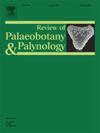Late Middle Pleistocene palynostratigraphy and landscape evolution in Western and Central Europe: Will the real Holsteinian Please Stand Up?
IF 1.7
3区 地球科学
Q2 PALEONTOLOGY
引用次数: 0
Abstract
The chronostratigraphic position of the Holsteinian interglacial is a long-standing debate. Although few doubt the typical vegetation dynamics reflected in pollen diagrams, some researchers still disagree about the age: Marine Isotope Stage (MIS) 11 or MIS 9. At the same time, this disagreement hinders the construction of a solid late Middle Pleistocene (LMP) palynostratigraphic framework for Western and Central Europe. The presented solution focuses simultaneously on the chronostratigraphic position of the Holsteinian and the development of a palynostratigraphic framework by combining the palynology with the stratigraphic context of organic LMP deposits. The authors demonstrate the differences in geomorphological position and vegetation dynamics between the MIS 11 Holsteinian on the one hand and MIS 9 sequences on the other by visually comparing pollen diagrams and looking for MIS 9 and MIS 7 correlations in Western and Central Europe. Some pollen profiles previously interpreted as Cromerian reflect MIS 9 palynology as described in this paper. The revised palynostratigraphic framework results in a new landscape evolution model, a compromise between the law of superposition and river terrace models, that explains the stratigraphic context of the different LMP interglacial complexes, i.e. MIS 11, 9 and 7: a phase of pronounced fluvial incision during MIS 10 was followed by net accumulation during MIS 9–8-7 in Western and Central Europe.
中更新世晚期西欧和中欧的古地层与景观演化:真正的荷斯泰因人会站起来吗?
荷尔斯泰因间冰期的年代地层位置是一个长期争论的问题。虽然很少有人怀疑花粉图所反映的典型植被动态,但一些研究人员对年龄仍然存在分歧:海洋同位素阶段(MIS) 11或MIS 9。同时,这种分歧也阻碍了西欧和中欧晚中更新世(LMP)孢粉地层格架的构建。提出的解决方案将孢粉学与有机LMP矿床的地层背景结合起来,同时关注荷尔斯坦系的年代地层位置和孢粉地层格架的发展。作者通过视觉比较花粉图和寻找西欧和中欧地区MIS 9和MIS 7的相关性,证明了MIS 11和MIS 9序列在地貌位置和植被动态上的差异。一些以前被解释为Cromerian的花粉谱反映了本文描述的MIS 9孢粉学。修正后的孢粉地层格架产生了一种新的景观演化模式,它是叠加规律和河流阶地模式之间的折衷,解释了不同LMP间冰期复合体(MIS 11、MIS 9和MIS 7)的地层背景:在西欧和中欧,MIS 10期间明显的河流切割阶段随后是MIS 9-8-7期间的净堆积阶段。
本文章由计算机程序翻译,如有差异,请以英文原文为准。
求助全文
约1分钟内获得全文
求助全文
来源期刊
CiteScore
3.50
自引率
21.10%
发文量
149
审稿时长
6 months
期刊介绍:
The Review of Palaeobotany and Palynology is an international journal for articles in all fields of palaeobotany and palynology dealing with all groups, ranging from marine palynomorphs to higher land plants. Original contributions and comprehensive review papers should appeal to an international audience. Typical topics include but are not restricted to systematics, evolution, palaeobiology, palaeoecology, biostratigraphy, biochronology, palaeoclimatology, paleogeography, taphonomy, palaeoenvironmental reconstructions, vegetation history, and practical applications of palaeobotany and palynology, e.g. in coal and petroleum geology and archaeology. The journal especially encourages the publication of articles in which palaeobotany and palynology are applied for solving fundamental geological and biological problems as well as innovative and interdisciplinary approaches.

 求助内容:
求助内容: 应助结果提醒方式:
应助结果提醒方式:


